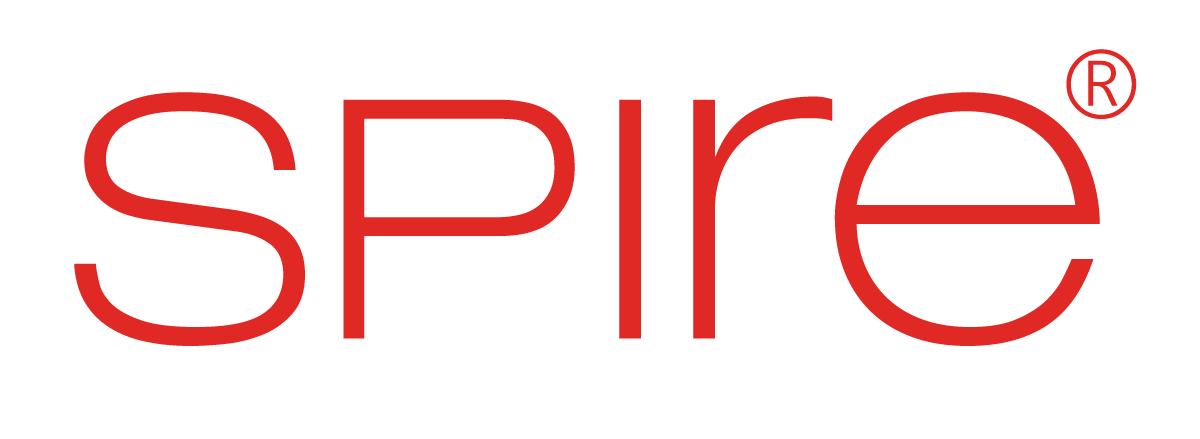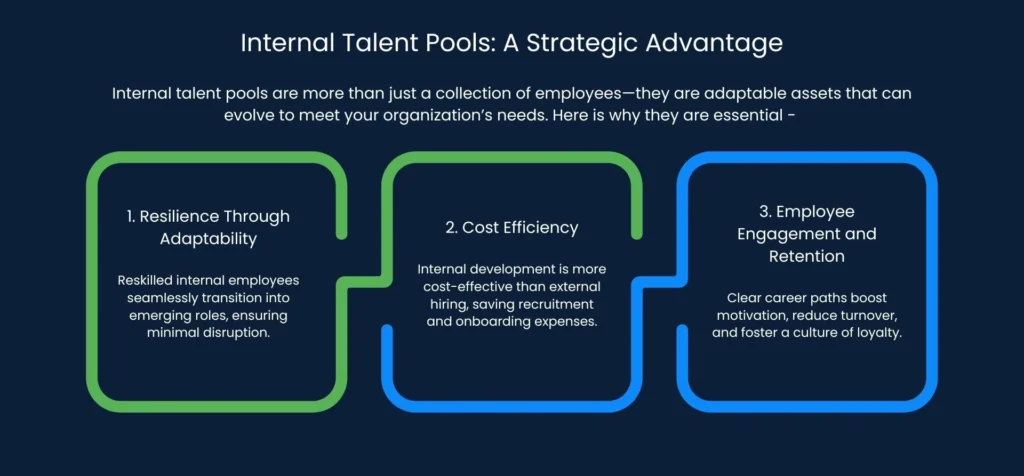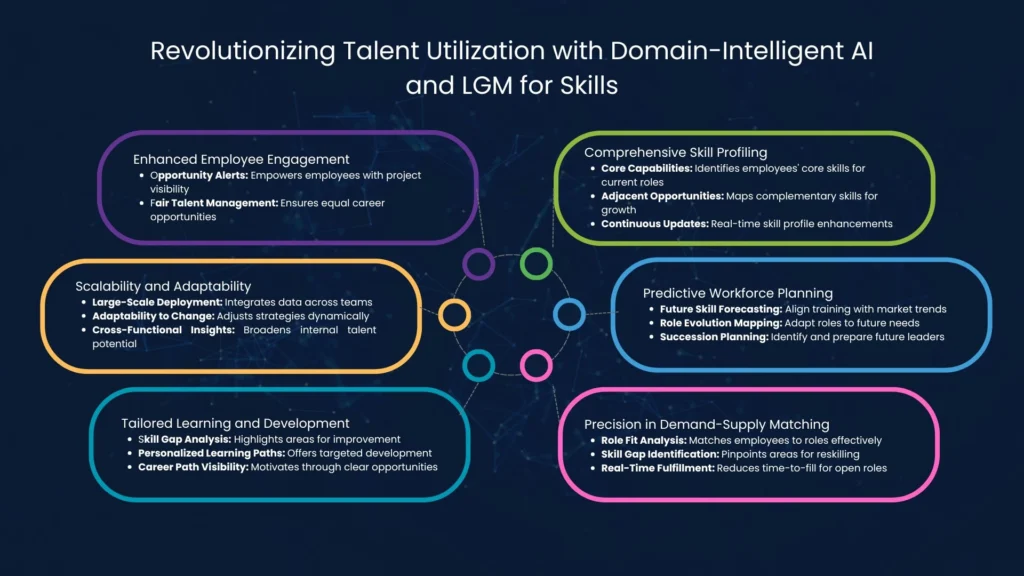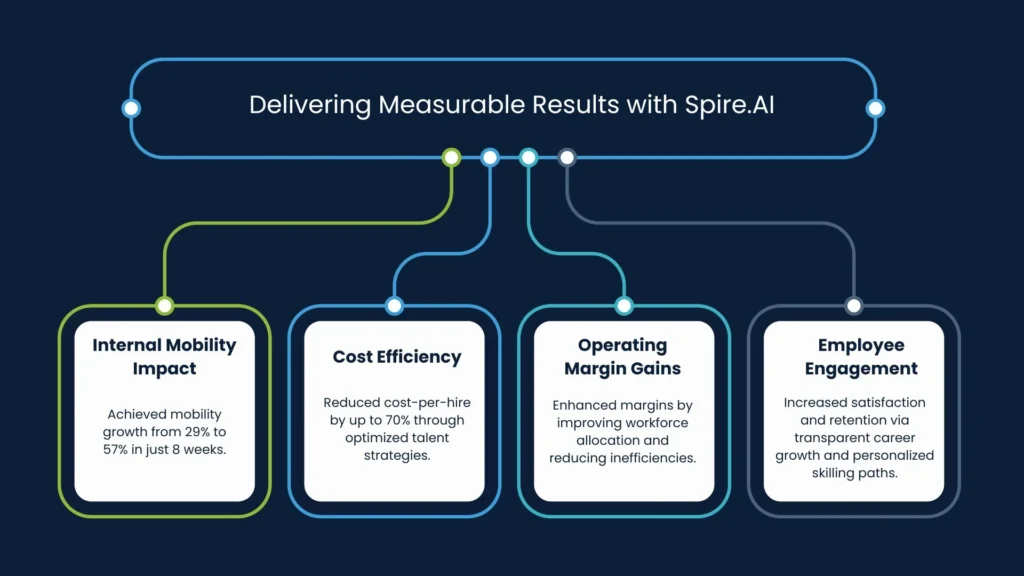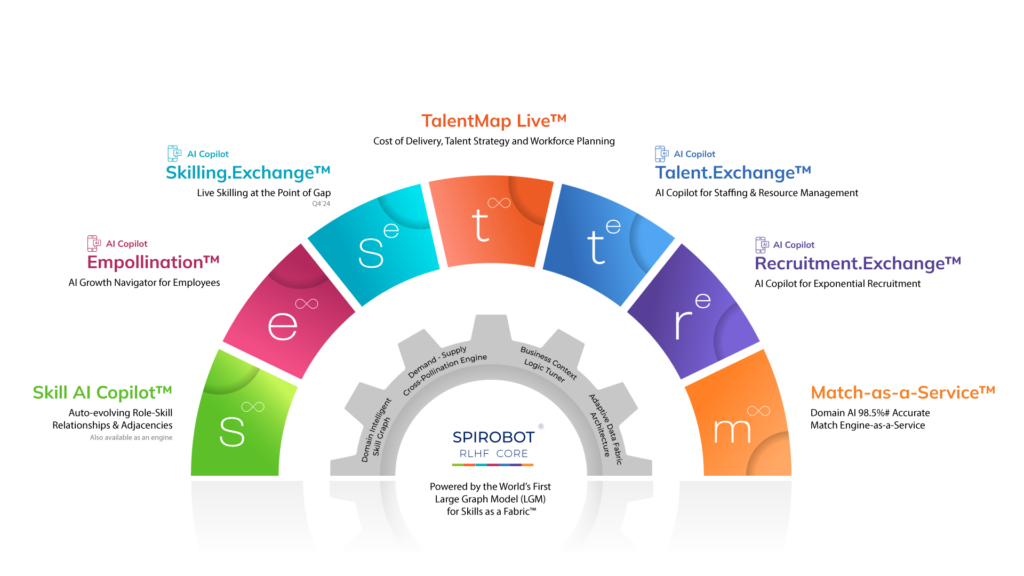This blog outlines why internal talent pools should be the foundation of a workforce strategy, how technology like Domain-Intelligent AI and Large Graph Models (LGM) for Skills can empower organizations to upskill employees, and when external hiring should be strategically utilized for specific roles.
Why Internal Talent Pools Should Be the Foundation
An internal talent pool isn’t just a repository of current employees; it’s a dynamic asset that can adapt and evolve to meet business needs. Focusing on internal mobility and skilling minimizes costs and ensures organizational resilience and employee loyalty.
1. Resilience Through Adaptability
Internal employees already understand the business context, culture, and workflows. With the right reskilling and upskilling efforts, they can be redeployed into emerging roles, ensuring minimal disruption during periods of transformation.
2. Cost Efficiency
The costs of external hiring—recruitment, onboarding, and lost productivity during ramp-up—are significantly higher than those of nurturing and developing internal talent. By leveraging internal talent pools, organizations can allocate resources more strategically.
3. Employee Engagement and Retention
When employees see clear career paths and opportunities within their organization, they are more motivated and less likely to leave. This sense of security fosters a culture of loyalty and engagement.
Limitations Without The Right Technology
While internal talent pools are invaluable, managing and optimizing them without the right tools can be challenging. Traditional approaches often lack visibility into employee skills and their alignment with future demands. This is where technologies like Domain-Intelligent AI and LGM for Skills transform the equation.
How Domain-Intelligent AI and Large Graph Models (LGM) for Skills Transform Internal Talent Pool Utilization
Maximizing the potential of an internal talent pool requires a precise understanding of employee skills, growth potential, and alignment with evolving business needs. Traditional talent management approaches often lack the scalability and insights to keep pace with rapid changes. However, advanced technologies like Domain-Intelligent AI and Large Graph Models (LGM) for Skills revolutionize how organizations harness internal talent by providing granular visibility, predictive insights, and actionable recommendations.
1. Comprehensive and Dynamic Skill Profiling
Domain-Intelligent AI automates the creation of detailed employee skill profiles by analyzing existing data such as job titles, certifications, project histories, and performance metrics. This dynamic profiling provides a panoramic view of employees’ capabilities, including their core competencies, soft skills, and adjacent abilities.
- Core Capabilities: Identifies primary skills employees excel in, ensuring the best fit for current roles.
- Adjacent Opportunities: Maps adjacent or complementary skills that employees can develop to transition into new roles.
- Continuous Updates: Skill profiles are continuously updated to reflect learning progress, completed training, and new experiences.
This process eliminates manual effort and ensures accuracy, giving organizations a real-time view of their workforce’s strengths and potential.
2. Predictive Workforce Planning for Evolving Demands
Large Graph Models (LGM) for Skills use interconnected skill data to predict workforce needs. By analyzing trends, market shifts, and internal data, these models provide insights into the skills that will be critical in the near and long term.
- Future Skill Forecasting: Predicts skills likely to be in demand based on industry trends, enabling organizations to align training initiatives proactively.
- Role Evolution Mapping: Helps define how existing roles will evolve and what new skills employees need to stay relevant.
- Succession Planning: Identifies high-potential employees for leadership roles, equipping them with the skills required to succeed in the future.
This proactive approach ensures that internal talent remains aligned with the organization’s strategic objectives.
3. Precision in Demand-Supply Matching
Domain-Intelligent AI and LGM for Skills enable highly accurate matching of employee skills to business needs, ensuring every opportunity is fulfilled internally before considering external hiring.
- Role Fit Analysis: Matches employees to roles based on both their current skills and potential to grow into the role.
- Skill Gap Identification: Identifies gaps between role requirements and employee skills, offering tailored recommendations for reskilling or upskilling.
- Real-Time Fulfillment: Provides instant insights into available talent for open positions, reducing time-to-fill and ensuring operational continuity.
This precision reduces inefficiencies and maximizes the utilization of internal talent.
4. Tailored Learning and Development
By leveraging Domain-Intelligent AI, organizations can create personalized learning paths for employees to address skill gaps and prepare for future roles.
- Skill Gap Analysis: Automatically identifies gaps between employee capabilities and future role requirements.
- Personalized Learning Paths: Recommends targeted training, certifications, or mentorship opportunities tailored to each employee’s career trajectory.
- Career Path Visibility: Provides employees with clear, actionable career pathways, motivating them to pursue growth opportunities.
This approach ensures employees are prepared for immediate demands and continuously growing to meet future needs.
5. Scalability and Adaptability in Talent Management
One of the most significant advantages of these technologies is their scalability. Whether an organization has hundreds or thousands of employees, Domain-Intelligent AI and LGM for Skills can analyze vast datasets, uncover trends, and provide actionable insights.
- Large-Scale Deployment: Works seamlessly across global teams, integrating data from multiple sources to create a unified view of talent.
- Adaptability to Change: Quickly adjusts recommendations and strategies based on shifting business needs or market conditions.
- Cross-Functional Insights: Helps organizations identify talent capable of transitioning across functions or geographies, broadening their internal talent pool.
6. Enhanced Employee Engagement Through Transparency
When employees see their skills are valued and actively managed, their engagement increases. Organizations foster a culture of growth and mutual commitment by providing clear insights into their career paths and the learning opportunities available.
- Opportunity Alerts: Employees receive alerts for roles and projects they are suited for, creating a sense of empowerment.
- Fair and Objective Talent Management: AI-driven insights reduce biases in career progression decisions, ensuring equal opportunities for all employees.
Reframing External Hiring: A Strategic Complement
While internal talent pools should be the primary focus, external hiring remains valuable when approached strategically. It should complement internal efforts rather than overshadow them and focus on areas where internal talent cannot fulfill immediate needs.
When to Prioritize External Hiring– Specialized Roles
– Entry-Level Recruitment
– Leadership Positions
When to Prioritize External Hiring
- Specialized Roles
External hiring is best suited for niche roles requiring particular expertise not available internally, such as advanced data analytics or emerging technologies. - Entry-Level Recruitment
Bringing in fresh talent at the entry-level creates a pipeline of future leaders while maintaining an influx of new perspectives. - Leadership Positions
For senior roles requiring strategic vision or external industry insights, external hiring can bring in the expertise needed for high-impact decisions.
The Ideal Workforce Strategy: Balance with Technology
To strike the right balance, organizations must adopt a structured, technology-driven approach that prioritizes internal talent while supplementing it strategically with external hires.
1. Build a Skills-Based Operating Model
Shift from traditional job-role frameworks to a skills-first approach, where workforce planning focuses on skills and competencies rather than predefined roles.
2. Reskill and Upskill Continuously
Invest in programs that address evolving business needs. Leveraging Domain-Intelligent AI ensures employees are guided toward the skills most critical for their development and organizational growth.
3. Strategic External Hiring
Focus external recruitment efforts on filling roles that cannot be fulfilled internally, ensuring they align with long-term goals rather than short-term fixes.
4. Leverage Data for Decision-Making
Use technologies like Domain-Intelligent AI and Large Graph Model (LGM) for Skills to gain real-time insights into skill gaps, employee potential, and hiring needs, enabling data-driven workforce decisions.
Spire.AI Copilot for Talent: Empowering Internal Talent First
Spire.AI redefines workforce strategy by making internal talent the cornerstone of organizational success. Its advanced Domain-Intelligent AI and Large Graph Models (LGM) for Skills equip organizations with the tools to prioritize internal talent pool utilization, ensuring that existing employees are skilled, redeployed, and leveraged effectively before turning to external hiring. This approach minimizes costs, maximizes efficiency, and aligns workforce capabilities with evolving business needs.
1. Comprehensive Skill Profiling with Domain-Intelligent AI
Domain-Intelligent AI automatically generates detailed and dynamic employee skill profiles by analyzing data from resumes, certifications, job histories, and performance records. These profiles are enriched with Spire.AI proprietary knowledge graphs, which include over 10 million skill nodes spanning 26 distinct verticals.
- Current and Adjacent Skills: Identifies existing skills and potential growth areas, helping organizations understand their workforce’s full potential.
- Auto-Evolving Profiles: Continuously updates skill profiles as employees gain new experiences or complete training, ensuring real-time accuracy.
- Minimal Input Required: Generates profiles from limited input, such as job titles or certifications.
This automated profiling eliminates manual efforts and provides unparalleled visibility into the organization’s internal talent pool.
2. Matching Internal Talent to Business Needs with Precision
The Spire.AI Large Graph Model (LGM) for Skills analyzes interconnected data to provide precise matches between employee skills and organizational demands.
- Demand-Supply Optimization: Matches open roles with the best internal candidates, considering skill relevance, career aspirations, and adjacent capabilities.
- Skill Gap Insights: Identifies gaps between role requirements and employee skills, offering actionable recommendations for targeted upskilling.
- Real-Time Role Fulfillment: Reduces time-to-fill for open positions by instantly surfacing qualified internal candidates, ensuring seamless operations.
By prioritizing internal mobility, Spire.AI reduces dependency on external hiring and ensures that internal talent is utilized to its fullest potential.
3. Proactive Workforce Planning for Emerging Demands
With Spire.AI, organizations can forecast future workforce needs and align their internal talent pool accordingly. Its predictive analytics capabilities identify emerging roles and critical skill gaps, enabling proactive planning.
- Future Role Mapping: Predicts how existing roles will evolve and what skills will be needed to fill them.
- Succession Planning: Identifies high-potential employees and prepares them for leadership roles through personalized learning and development plans.
- Strategic Workforce Alignment: Aligns internal talent strategies with long-term business objectives, ensuring readiness for future challenges.
This forward-looking approach ensures that organizations remain agile and prepared for market shifts.
4. Personalized Learning and Skilling at Scale
Spire.AI empowers employees with tailored learning paths to address their unique skill gaps and career aspirations.
- Actionable Skilling Recommendations: Uses skill gap analyses to recommend specific training programs, certifications, or mentorship opportunities.
- Career Path Simulations: Provides employees with clear visibility into lateral and vertical career opportunities, helping them make informed decisions.
- Continuous Skilling: Encourages employees to tag desired skills for learning, which are then integrated into personalized development plans.
By fostering a culture of continuous learning, Spire.AI ensures that internal talent remains competitive and aligned with business needs.
5. External Hiring as a Proactive Measure
While Spire.AI emphasizes internal talent first, it also supports strategic external hiring for roles that cannot be fulfilled internally. For niche or entry-level positions, Spire.AI recruitment solutions ensure precision and efficiency in identifying and recruiting suitable candidates.
- Focused External Recruitment: Targets specific gaps in expertise, ensuring external hires complement internal capabilities.
- Efficient Candidate Matching: Leverages Domain-Intelligent AI to match candidates to roles with unparalleled accuracy, reducing time-to-hire.
- Cost Savings in Hiring: Minimizes recruitment costs by identifying external needs and avoiding unnecessary hiring efforts.
This balanced approach ensures external hiring is strategic rather than reactive.
Real Business Impact with Spire.AI
Organizations using Spire.AI experience tangible benefits within weeks of deployment, as its tools transform talent management from a transactional process into a strategic advantage.
- Internal Mobility Impact: Achieves significant increases in internal mobility, with some organizations reporting improvements from 29% to 57% within eight weeks.
- Cost Efficiency: Reduces cost-per-hire by up to 70% through optimized internal talent utilization and precise external recruitment.
- Operating Margin Gains: Enhances operating margins by improving workforce allocation and reducing inefficiencies.
- Employee Engagement: Boosts employee satisfaction and retention through transparent career growth opportunities and personalized skilling paths.
Final Thoughts
Striking the right balance between leveraging internal talent pools and pursuing external hiring is not just a tactical decision but a strategic imperative for organizations aiming to stay competitive in a rapidly evolving landscape. Prioritizing internal talent ensures continuity, reduces costs, and cultivates a culture of growth and loyalty. Businesses can align their workforce capabilities with future demands and evolving roles by empowering employees with targeted reskilling and upskilling opportunities.
However, external hiring remains a valuable complement, particularly for niche expertise and entry-level positions. The key lies in ensuring that external recruitment is strategic, precise, and aligned with long-term business goals rather than short-term gaps.
Advanced technologies like Domain-Intelligent AI and Large Graph Models (LGM) for Skills make this balance achievable by providing real-time visibility into workforce capabilities and delivering actionable insights for proactive talent management. With these tools, organizations can seamlessly unlock the potential of their internal talent while strategically addressing gaps through focused external hiring.
Ultimately, the organizations that thrive will recognize the power of their internal talent and invest in the technologies and strategies needed to harness it fully. By putting internal talent pools first, supported by intelligent external hiring, businesses can build resilient, agile, and future-ready workforces that drive sustained success.
